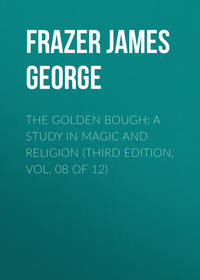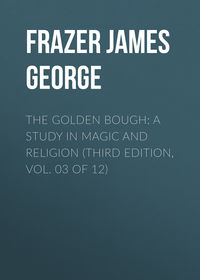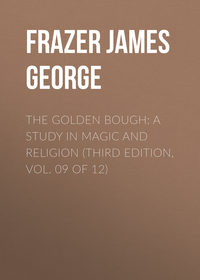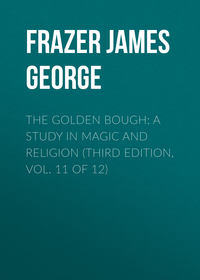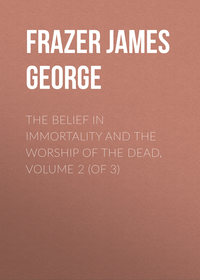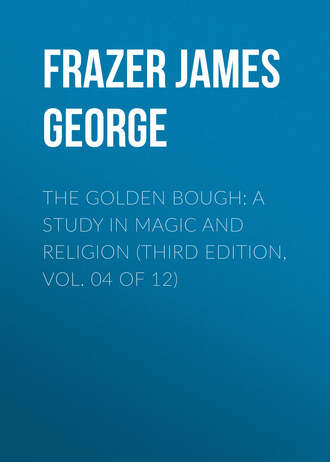 полная версия
полная версияThe Golden Bough: A Study in Magic and Religion (Third Edition, Vol. 04 of 12)
54
On the use of flowing blood in rain-making ceremonies see The Magic Art and the Evolution of Kings, i. 256, 257 sq.
55
Dr. C. G. Seligmann, The Shilluk Divine Kings (in manuscript).
56
On this subject Dr. Seligmann writes to me (March 9th, 1911) as follows: “The assumption of the throne as the result of victory in single combat doubtless occurred once; at the present day and perhaps for the whole of the historic period it has been superseded by the ceremonial killing of the king, but I regard these stories as folk-lore indicating what once really happened.”
57
These particulars I take from letters of Dr. C. G. Seligmann's to me (dated 8th February and 9th March 1911). They are not mentioned in the writer's paper on the subject.
58
When one of the king's wives is with child, she remains at Fashoda till the fourth or fifth month of her pregnancy; she is then sent away to a village, not necessarily her own, where she remains under the charge of the village chief until she has finished nursing the child. Afterwards she returns to Fashoda, but the child invariably remains in the village of his or her birth and is brought up there. All royal children of either sex, in whatever part of the Shilluk territory they may happen to die, are buried the village where they were born.
59
As to the disappearance of the early Roman kings see The Magic Art and the Evolution of Kings, vol. ii. pp. 312 sqq.; as to the disappearance of the early kings of Uganda, see the Rev. J. Roscoe, The Baganda (London, 1911), p. 214.
60
See The Magic Art and the Evolution of Kings, i. 1 sqq., ii. 376 sqq.
61
“E. de Pruyssenaere's Reisen und Forschungen im Gebiete des Weissen und Blauen Nil,” Petermann's Mittheilungen, Ergänzungsheft, No. 50 (Gotha, 1877), pp. 18-23. Compare G. Schweinfurth, The Heart of Africa, Third Edition (London, 1878), i. 48 sqq. In the text I have followed de Pruyssenaere's description of the privations endured by the Dinka in the dry season. But that description is perhaps only applicable in seasons of unusual drought, for Dr. C. G. Seligmann, writing from personal observation, informs me that he regards the description as much overdrawn; in an average year, he tells me, the cattle do not die of famine and the natives are not starving. According to his information the drinking of the blood of their cattle is a luxury in which the Dinka indulge themselves at any time of the year.
62
For this and the following information as to the religion, totemism, and rain-makers of the Dinka I am indebted to the kindness of Dr. C. G. Seligmann, who investigated the Shilluk and Dinka in 1909-1910 and has most obligingly placed his manuscript materials at my disposal.
63
On the importance of the rain-makers among the Dinka and other tribes of the Upper Nile, see The Magic Art and the Evolution of Kings, i. 345 sqq.
64
Emin Pasha in Central Africa, being a Collection of his Letters and Journals (London, 1888), p. 91; J. G. Frazer, Totemism and Exogamy, ii. 529 sq. (from information given by the Rev. John Roscoe).
65
Father Guillemé, in Annales de la Propagation de la Foi, lx. (1888) p. 258; id., “Credenze religiose dei Negri di Kibanga nell' Alto Congo,” Archivio per lo studio delle tradizioni popolari, vii. (1888) p. 231.
66
The Travels of the Jesuits in Ethiopia, collected and historically digested by F. Balthazar Tellez, of the Society of Jesus (London, 1710), p. 197. We may compare the death of Saul (1 Samuel, xxxi. 3-6).
67
Lieut. H. Pope-Hennessy, “Notes on the Jukos and other Tribes of the Middle Benue,” Journal of the Anthropological Institute, xxx. (1900) p. (29).
68
J. G. Frazer, Totemism and Exogamy, ii. 608, on the authority of Mr. H. R. Palmer, Resident in Charge of Katsina.
69
F. T. Valdez, Six Years of a Traveller's Life in Western Africa (London, 1861), ii. 194 sq.
70
Nathaniel Isaacs, Travels and Adventures in Eastern Africa (London, 1836), i. 295 sq., compare pp. 232, 290 sq.
71
The Magic Art and the Evolution of Kings, i. 392.
72
J. dos Santos, “Eastern Ethiopia,” in G. McCall Theal's Records of Southeastern Africa, vii. (1901) pp. 194 sq. A more highly-flavoured and full-bodied, though less slavishly accurate, translation of this passage is given in Pinkerton's Voyages and Travels, xvi. 684, where the English translator has enriched the unadorned simplicity of the Portuguese historian's style with “the scythe of time” and other flowers of rhetoric.
73
J. dos Santos, op. cit. p. 193.
74
Xenophon, Hellenica, iii. 3. 3; Plutarch, Agesilaus, 3; id., Lysander, 22; Pausanias, iii. 8. 9.
75
Herodotus, iii. 20; Aristotle, Politics, iv. 4. 4.; Athenaeus, xiii. 20, p. 566. According to Nicolaus Damascenus (Fr. 142, in Fragmenta historicorum Graecorum, ed. C. Müller, iii. p. 463), the handsomest and bravest man was only raised to the throne when the king had no heirs, the heirs being the sons of his sisters. But this limitation is not mentioned by the other authorities.
76
G. Nachtigal, Saharâ und Sûdân, iii. (Leipsic, 1889) p. 225; A. Bastian, Die deutsche Expedition an der Loango-Küste (Jena, 1874-75), i. 220.
77
P. W. Joyce, Social History of Ancient Ireland (London, 1903), i. 311.
78
Strabo, xvii. 2. 3, p. 823; Diodorus Siculus, iii. 7.
79
Mohammed Ebn-Omar El-Tounsy, Voyage au Darfour (Paris, 1845), pp. 162 sq.; Travels of an Arab Merchant in Soudan, abridged from the French by Bayle St. John (London, 1854), p. 78; Bulletin de la Société de Géographie (Paris), IVme Série, iv. (1852) pp. 539 sq.
80
R. W. Felkin, “Notes on the Waganda Tribe of Central Africa,” in Proceedings of the Royal Society of Edinburgh, xiii. (1884-1886) p. 711; J. Roscoe, “Further Notes on the Manners and Customs of the Baganda,” Journal of the Anthropological Institute, xxxii. (1902) p. 77 (as to sneezing).
81
Narrative of Events in Borneo and Celebes, from the Journal of James Brooke, Esq., Rajah of Sarawak, by Captain R. Mundy, i. 134. My friend the late Mr. Lorimer Fison, in a letter of August 26th, 1898, told me that the custom of falling down whenever a chief fell was observed also in Fiji, where it had a special name, bale muri, “fall-follow.”
82
Mgr. Bruguière, in Annales de l'Association de la Propagation de la Foi, v. (1831) pp. 174 sq.
83
A. Dalzel, History of Dahomy (London, 1793), pp. 12 sq., 156 sq.
84
Father Baudin, “Le Fétichisme ou la religion des Nègres de la Guinée,” Missions Catholiques, xvi. (1884) p. 215.
85
Missionary Holley, “Étude sur les Egbas,” Missions Catholiques, xiii. (1881) pp. 351 sq. Here Oyo is probably the same as Eyeo mentioned above.
86
Simon Grunau, Preussische Chronik, herausgegeben von Dr. M. Perlbach (Leipsic, 1876), i. p. 97.
87
Lucian, De morte Peregrini. That Lucian's account of the mountebank's death is not a fancy picture is proved by the evidence of Tertullian, Ad martyres, 4, “Peregrinus qui non olim se rogo immisit.”
88
D. S. Macgowan, M.D., “Self-immolation by Fire in China,” The Chinese Recorder and Missionary Journal, xix. (1888) pp. 445-451, 508-521.
89
E. W. Nelson, “The Eskimo about Bering Strait,” Eighteenth Annual Report of the Bureau of American Ethnology, Part I. (Washington, 1899), pp. 320, 433 sq.
90
Revelation xx. 1-3.
91
Revelation xiii. 18.
92
Ivan Stchoukine, Le Suicide collectif dans le Raskol russe (Paris, 1903), pp. 45-53, 61-78, 84-87, 96-99, 102-112. The mania in its most extreme form died away towards the end of the seventeenth century, but during the eighteenth and nineteenth centuries cases of collective suicide from religious motives occurred from time to time, people burning themselves in families or in batches of thirty or forty. The last of these suicides by fire took place in 1860, when fifteen persons thus perished in the Government of Olonetz. Twenty-four others buried themselves alive near Tiraspol in the winter of 1896-97. See I. Stchoukine, op. cit. pp. 114-126.
93
Voltaire, Essai sur les Mœurs, iii. 142-145 (Œuvres complètes de Voltaire, xiii. Paris, 1878).
94
Duarte Barbosa, A Description of the Coasts of East Africa and Malabar in the Beginning of the Sixteenth Century (Hakluyt Society, London, 1866), pp. 172 sq.
95
L. di Varthema, Travels, translated by J. W. Jones and edited by G. P. Badger (Hakluyt Society, London, 1863), p. 134. In a note the Editor says that the name Zamorin (Samorin) according to some “is a corruption of Tamuri, the name of the most exalted family of the Nair caste.”
96
Francis Buchanan, “Journey from Madras through the Countries of Mysore, Canara, and Malabar,” in Pinkerton's Voyages and Travels, viii. 735.
97
Alex. Hamilton, “A New Account of the East Indies,” in Pinkerton's Voyages and Travels, viii. 374.
98
The sidereal revolution of Jupiter is completed in 11 years 314.92 days (Encyclopaedia Britannica, Ninth Edition, s. v. “Astronomy,” ii. 808). The twelve-years revolution of Jupiter was known to the Greek astronomers, from whom the knowledge may perhaps have penetrated into India. See Geminus, Eisagoge, I, p. 10, ed. Halma.
99
W. Logan, Malabar (Madras, 1887), i. 162-169. The writer describes in particular the festival of 1683, when fifty-five men perished in the manner described.
100
Sir H. M. Elliot, The History of India as told by its own Historians, iv. 260. I have to thank Mr. R. S. Whiteway, of Brownscombe, Shottermill, Surrey, for kindly calling my attention to this and the following instance of the custom of regicide.
101
De Barros, Da Asia, dos feitos, que os Portuguezes fizeram no descubrimento e conquista dos mares e terras do Oriente, Decada Terceira, Liv. V. cap. i. pp. 512 sq. (Lisbon, 1777).
102
Saxo Grammaticus,Historia Danica, viii. pp. 410 sq., ed. P. E. Müller (p. 334 of Mr. Oliver Elton's English translation).
103
T. K. Gopal Panikkar (of the Madras Registration Department), Malabar and its Folk (Madras, N. D., preface dated Chowghaut, 8th October 1900), pp. 120 sq. I have to thank my friend Mr. W. Crooke for calling my attention to this account.
104
Voyage d'Ibn Batoutah, texte arabe, accompagné d'une traduction par C. Deffrémery et B. R. Sanguinetti (Paris, 1853-58), iv. 246 sq.
105
The Wonders of the East, by Friar Jordanus, translated by Col. Henry Yule (London, 1863, Hakluyt Society), pp. 32 sq.
106
India in the Fifteenth Century, being a Collection of Voyages to India in the century preceding the Portuguese discovery of the Cape of Good Hope, edited by R. H. Major (Hakluyt Society, London, 1857), “The Travels of Nicolo Conti in the East,” pp. 27 sq. An instrument of the sort described in the text (a crescent-shaped knife with chains and stirrups attached to it for the convenience of the suicide) used to be preserved at Kshira, a village of Bengal near Nadiya: it was called a karavat. See The Book of Ser Marco Polo, newly translated and edited by Colonel Henry Yule, Second Edition (London, 1875), ii. 334.
107
Major P. R. T. Gurdon, The Khasis (London, 1907), pp. 102 sq., quoting Mr. Gait in the Journal of the Asiatic Society of Bengal for 1898.
108
E. T. Dalton, Descriptive Ethnology of Bengal (Calcutta, 1872), p. 146.
109
F. T. Valdez, Six Years of a Traveller's Life in Western Africa (London, 1861), ii. 158-160. I have translated the title Maquita by “chief”; the writer does not explain it.
110
Ynglinga Saga, 29 (The Heimskringla, translated by S. Laing, i. 239 sq.). Compare H. M. Chadwick, The Cult of Othin (London, 1899), p. 4. According to Messrs. Laing and Chadwick the sacrifice took place every tenth year. But I follow Prof. K. Weinhold who translates “hit tiunda hvert ár” by “alle neun Jahre” (“Die mystische Neunzahl bei den Deutschen,” Abhandlungen der könig. Akademie der Wissenschaften zu Berlin, 1897, p. 6). So in Latin decimo quoque anno should be translated “every ninth year.”
111
Saxo Grammaticus, Historia Danica, iii. pp. 129-131, ed. P. E. Müller (pp. 98 sq. of Oliver Elton's English translation).
112
Adam of Bremen, Descriptio insularum Aquilonis, 27 (Migne's Patrologia Latina, cxlvi. col. 644). See The Magic Art and the Evolution of Kings, vol. ii. pp. 364 sq.
113
Plutarch, Agis, II. Plutarch says that the custom was observed “at intervals of nine years” (δι᾽ ἐτῶν ἐννέα), but the expression is equivalent to our “at intervals of eight years.” In reckoning intervals of time numerically the Greeks included both the terms which are separated by the interval, whereas we include only one of them. For example, our phrase “every second day” would be rendered in Greek διὰ τρίτης ἡμέρας, literally “every third day.” Again, a cycle of two years is in Greek trieteris, literally “a period of three years”; a cycle of eight years is ennaeteris, literally “a period of nine years”; and so forth. See Censorinus, De die natali, 18. The Latin use of the ordinal numbers is similar, e. g. our “every second year” would be tertio quoque anno in Latin. However, the Greeks and Romans were not always consistent in this matter, for they occasionally reckoned in our fashion. The resulting ambiguity is not only puzzling to moderns; it sometimes confused the ancients themselves. For example, it led to a derangement of the newly instituted Julian calendar, which escaped detection for more than thirty years. See Macrobius, Saturn. i. 14. 13 sq.; Solinus, i. 45-47. On the ancient modes of counting in such cases see A. Schmidt, Handbuch der griechischen Chronologie (Jena, 1888), pp. 95 sqq. According to Schmidt, the practice of adding both terms to the sum of the intervening units was not extended by the Greeks to numbers above nine.
114
Die Dorier,2 ii. 96.
115
E. Man, Aboriginal Inhabitants of the Andaman Islands, pp. 84 sq.
116
W. E. Roth, North Queensland Bulletin, No. 5, Superstition, Magic, and Medicine (Brisbane, 1903), p. 8.
117
A. W. Howitt, The Native Tribes of South-East Australia, p. 429.
118
A. W. Howitt, op. cit. p. 430. One of the earliest writers on New South Wales reports that the natives attributed great importance to the falling of a star (D. Collins,Account of the English Colony in New South Wales (London, 1804), p. 383).
119
Spencer and Gillen, Northern Tribes of Central Australia, p. 627.
120
Spencer and Gillen, op. cit. pp. 488, 627 sq.
121
G. Thilenius, Ethnographische Ergebnisse aus Melanesien, ii. (Halle, 1903) p. 129.
122
H. A. Junod, Les Ba-ronga (Neuchatel, 1898), p. 470.
123
A. C. Hollis, The Masai (Oxford, 1905), p. 316.
124
J. Campbell, Travels in South Africa (London, 1815), pp. 428 sq.
125
Id., Travels in South Africa, Second Journey (London, 1822), ii. 204.
126
G. Zündel, “Land und Volk der Eweer auf der Sclavenküste in Westafrika,” Zeitschrift der Gesellschaft für Erdkunde zu Berlin, xii. (1877) pp. 415 sq.; C. Spiess, “Religionsbegriffe der Evheer in Westafrika,” Mittheilungen des Seminars für Orientalische Sprachen zu Berlin, vi. (1903) Dritte Abtheilung, p. 112.
127
Boscana, “Chinigchinich, a Historical Account of the Origin, etc., of the Indians of St. Juan Capistrano,” in A. Robinson's Life in California (New York, 1846), p. 299.
128
C. Lumholtz, Unknown Mexico (London, 1903), i. 324 sq.
129
K. von den Steinen, Unter den Naturvölkern Zentral-Brasiliens (Berlin, 1894), pp. 514 sq. The Peruvian Indians also made a prodigious noise when they saw a shooting star. See P. de Cieza de Leon, Travels (Hakluyt Society, London, 1864), p. 232.
130
G. Kurze, “Sitten und Gebräuche der Lengua-Indianer,” Mitteilungen der Geographischen Gesellschaft zu Jena, xxiii. (1905) p. 17; W. Barbrooke Grubb, An Unknown People in an Unknown Land (London, 1911), p. 163.
131
M. Dobrizhoffer, Historia de Abiponibus (Vienna, 1784), ii. 86.
132
W. Tetzlaff, “Notes on the Laughlan Islands,” Annual Report on British New Guinea, 1890-91 (Brisbane, 1892), p. 105.
133
H. Oldenberg, Die Religion des Veda, p. 267.
134
W. Crooke, Popular Religion and Folklore of Northern India (Westminster, 1906), ii. 22.
135
Holzmayer, “Osiliana,” Verhandlungen der gelehrten Estnischen Gesellschaft zu Dorpat, vii. (1872) p. 48.
136
Guillain, Documents sur l'histoire, la géographie, et le commerce de l'Afrique Orientale, ii. (Paris, N.D.) p. 97; C. Velten, Sitten und Gebräuche der Suaheli (Göttingen, 1903), pp. 339 sq.; C. B. Klunzinger, Upper Egypt (London, 1878), p. 405; Budgett Meakin, The Moors (London, 1902), p. 353.
137
E. Dieffenbach, Travels in New Zealand (London, 1843), ii. 66. According to another account, meteors are regarded by the Maoris as betokening the presence of a god (R. Taylor, Te Ika a Maui, or New Zealand and its Inhabitants,2 p. 147).
138
Ch. Wilkes, Narrative of the United States Exploring Expedition, v. 88.
139
A. W. Howitt, Native Tribes of South-East Australia, p. 369.
140
A. W. Howitt, in Brough Smyth's Aborigines of Victoria, ii. 309.
141
E. Palmer, “Notes on some Australian Tribes,” Journal of the Anthropological Institute, xiii. (1884) p. 292. Sometimes apparently the Australian natives regard crystals or broken glass as fallen stars, and treasure them as powerful instruments of magic. See E. M. Curr, The Australian Race, iii. 29; W. E. Roth, North Queensland Ethnography, Bulletin No. 5, p. 8.
142
J. Macgillivray, Narrative of the Voyage of H.M.S. Rattlesnake (London, 1852), ii. 30.
143
P. A. Kleintitschen, Die Küstenbewohner der Gazellehalbinsel (Hiltrup bei Münster, n. d.), p. 227.
144
P. Rascher, “Die Sulka,” Archiv für Anthropologie, xxix. (1904) p. 216.
145
Dudley Kidd, Savage Childhood (London, 1906), p. 149.
146
J. Halkin, Quelques Peuplades du district de l'Uelé (Liège, 1907), p. 102.
147
O. Baumann, Durch Massailand zur Nilquelle (Berlin, 1894), p. 163.
148
O. Baumann, Durch Massailand zur Nilquelle (Berlin, 1894), p. 188.
149
E. Petitot, Monographie des Dènè-Dindjé (Paris, 1876), p. 60; id., Monographie des Esquimaux Tchiglit (Paris, 1876), p. 24.
150
A. Henry, “The Lolos and other Tribes of Western China,” Journal of the Anthropological Institute, xxxiii. (1903) p. 103.
151
Pliny, Nat. Hist. ii. 28.
152
F. Panzer, Beitrag zur deutschen Mythologie, ii. 293; A. Kuhn und W. Schwartz, Norddeutsche Sagen, Märchen und Gebräuche, p. 457, § 422; E. Meier, Deutsche Sagen, Sitten und Gebräuche aus Schwaben, p. 506, §§ 379, 380.
153
P. Sébillot, Traditions et superstitions de la Haute-Bretagne, ii. 353; J. Haltrich, Zur Volkskunde der Siebenbürger Sachsen (Vienna, 1885), p. 300; W. Schmidt, Das Jahr und seine Tage in Meinung und Brauch der Romänen Siebenbürgens, p. 38; E. Gerard, The Land beyond the Forest, i. 311; J. V. Grohmann, Aberglauben und Gebräuche aus Böhmen und Mähren, p. 31, § 164; Br. Jelínek, “Materialien zur Vorgeschichte und Volkskunde Böhmens,” Mittheilungen der anthropologischen Gesellschaft in Wien, xxi. (1891) p. 25; G. Finamore, Credenze, usi e costumi Abruzzesi, pp. 47 sq.; M. Placucci, Usi e pregiudizj dei contadini della Romagna (Palermo, 1885), p. 141; Holzmayer, “Osiliana,” Verhandl. der gelehrten Estnischen Gesellschaft zu Dorpat, vii. (1872) p. 48. The same belief is said to prevail in Armenia. See Minas Tchéraz, “Notes sur la mythologie arménienne,” Transactions of the Ninth International Congress of Orientalists (London, 1893), ii. 824. Bret Harte has employed the idea in his little poem, “Relieving Guard.”
154
H. Lew, “Der Tod und die Beerdigungs-gebräuche bei den polnischen Juden,” Mittheilungen der anthropologischen Gesellschaft in Wien, xxxii. (1902) p. 402.




